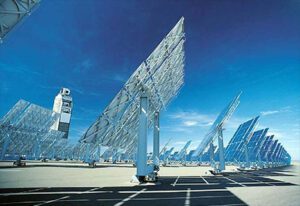Advanced Solar Thermal Desalination Projects Announced
Access to clean water is a growing problem for many cities and municipalities around the world. One answer is to build systems to remove the salt from seawater to provide a source of clean drinking water ( desalination). These systems typically require a lot of electricity. In many cases these same areas are remote and electricity is either expensive, unreliable or not available at all.
While solar pv systems can provide a source of electricity for desalination plants there is maybe a better option that offers a higher conversion efficiency. This other option is solar thermal desalination.
A parabolic solar concentrator from SkyFuel
Just this month, the U.S. Department of Energy (DOE) announced $21 million for 14 new advanced solar thermal projects to advance solar-desalination technologies. These projects are focused on reducing the cost of solar-thermal desalination and helping the technology to reach new markets, including to areas that are not connected to the electric grid.
Desalination treats seawater, brackish water, and contaminated water for use in municipal and industrial water supplies, or to serve other reclamation needs. Today’s desalination operations need to be grid-connected, limiting their applications to areas with electricity access. Solar-thermal power, which concentrates sunlight and converts it into heat, has the potential to expand access to desalination by enabling smaller, more portable systems that don’t have to be grid-connected.
Advanced solar thermal systems may be the future for desalination
Four markets that are particularly attractive for solar desalination technologies include:
- municipal water production,
- agriculture,
- industrial processes,
- the purification of water produced from energy development, including oil and gas extraction
Cost to Produce:
- Projects that address challenges for small-scale plants that process low-volume, high-salinity water, like brine from oil and gas operations, target a levelized cost of water (LCOW) of $1.50 per cubic meter.
- Projects that address challenges for large-scale plants that process high-volume, low-salinity water, like sea water for a municipal utility, are expected to target an LCOW of $0.50 per cubic meter.
The awardees represent industry, laboratory, and university researchers:
- Advanced Cooling Technologies, Inc. (Lancaster, Pennsylvania): $1.5 million
- Columbia University (New York, NY) $1 million
- Fraunhofer USA Center for Energy Innovation (Storrs, Connecticut): $800,000
- GreenBlu (Hamilton, New Jersey): $1.6 million
- Lawrence Berkeley National Laboratory (Berkeley, California): $800,000
- Natural Energy Laboratory of Hawaii Authority (Kailua-Kona, Hawaii): $2 million
- Oregon State University (Bend, Oregon): $2 million
- University of California: Los Angeles (Los Angeles, California): $2 million
- University of California: Merced (Merced, California): $1.1 million
- University of Illinois at Urbana-Champaign (Urbana, Illinois): $1.6 million
- University of North Dakota (Grand Forks, North Dakota): $2 million
- Rice University (Houston, Texas) $1.7 million
- SkyFuel, Inc (Lakewood, Colorado): $1.6 million
- Sunvapor, Inc. (Livermore, California): $1.5 million
Timing for these advanced solar thermal projects:
The projects are anticipated to last up to three years and will be awarded as cooperative agreements, which requires between 20 to 50 percent cost share. Cost share requirements ensure maximum return on taxpayer-funded research and development. In total, the projects represent a public-private investment of nearly $30 million.
Source NREL
Picture credit is Sunvapor.com

